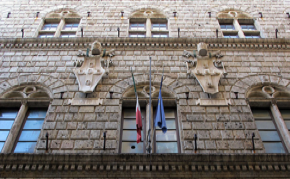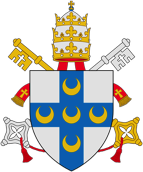Furthermore, to decipher stemmi one must be a sort of haberdasher as well. This is because families with ecclesiastical connections combined their family crest with either a cardinal's hat or a papal miter. A cardinal's hat is a brimmed hat with a very wide, flat rim with opulent tassels wrapped around and dangling from it. Sometimes a cardinal will elevate to Pope and sometimes not. There can be many cardinals and a pope simultaneously in a single family, or even a nobleman for that matter. Papal miters on stemmi come with crossed keys which seem to hold the ‘hat’ upright. The iconography here refers to Saint Peter: God said unto Peter, 'to you I give these keys and upon this rock you will build my church.'
Aside from papal miters and tassel bedecked hats, we have crowns for nobility or families with 'royal connections' that reach beyond the Italian borders. How does this come about; marriage, bargaining chips and favors, too. Take the Aldobrandini family crest: not only was there a pope in Clement VIII Aldobrandini, there were also cardinals, and somewhere along the line ‘arrangements’ were made that finds the family with their seal surmounted by a crown, signifying royalty. This coding does not require a specialization or scholarship in family crests, popes or cardinals or specific names, necessarily. The decoding is an overview based on the visual ‘hieroglyphics’ as presented.
Let's take the Piccolomini family from Pienza. The Palazzo Piccolomini on the piazza of their hometown, Pienza, display both the cardinal's hat and the papal miter placed above the Piccolomini cross and half-moons. Decoding here is simple: we are being told that Pius II Piccolomini (1458–1464) was, perhaps, first a cardinal and then the pope. This could mean that the palazzo was under construction while he was a cardinal and completed after he was elevated to Pope.
The family is identified by a blue cross with five half-moons, thus their family seal. The Palazzo Piccolomini defines one side of the trapezoidal piazza in Pienza and displays the family stemma over its main entrance(s), and more prominently, two attach themselves midway up the palace's corner. Corners are all important, because a corner, and therefore the stemma, can be viewed from more than one vantage point.
The next question which would require not only visual prompts, but curiosity, to find out why the half moons. Firstly, the blue cross started out as the family crest and then half moons were added until the final number of five was settled on. Because my curiosity is insatiable, I took a peek at the family history and, extraordinarily, the half moons came into the picture, so to speak, because the 16th Century Italian archbishop and astronomer Alessandro Piccolomini located a prominent lunar crater in the southeastern sector of the moon! This lunar impact crater is named Piccolomini after the archbishop/astronomer. Who knew?!
Page 2
Click monogram to return to home page


Piccolomini half moons and keys
Palazzo Piccolomini, Pienza, with two medallions
Palazzo Piccolomini corner
Typical cardinal's hat and other symbols at Palazzo Arcivescovile